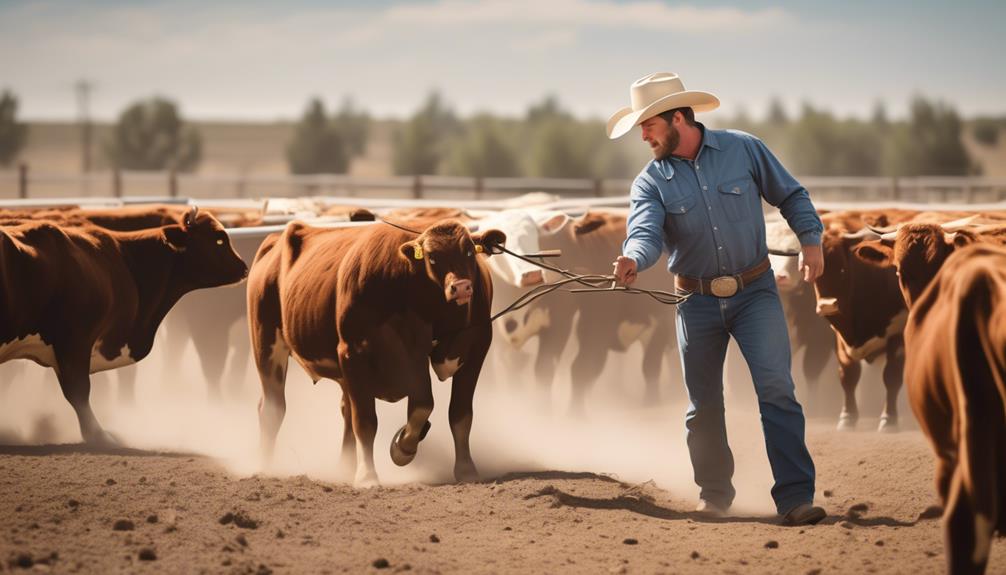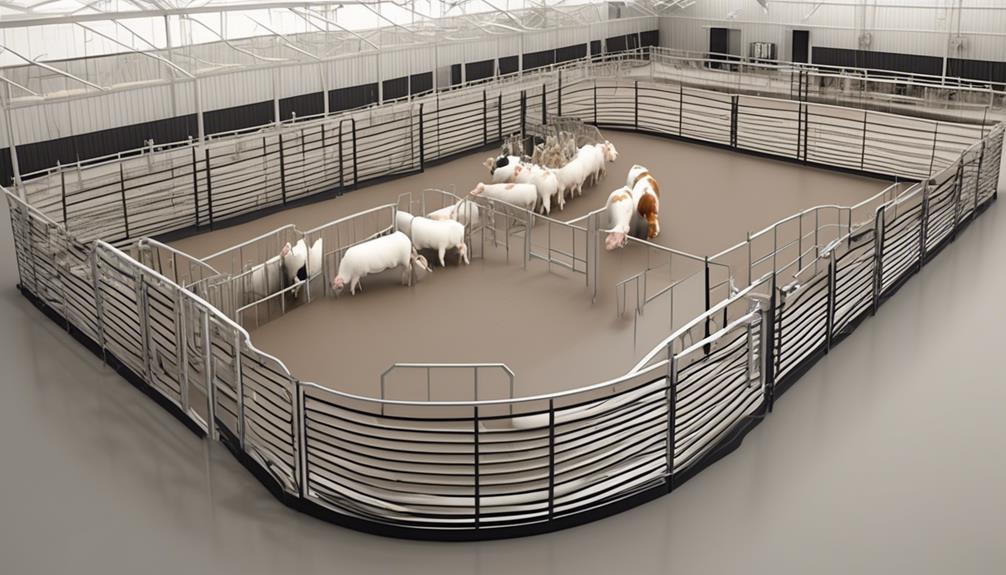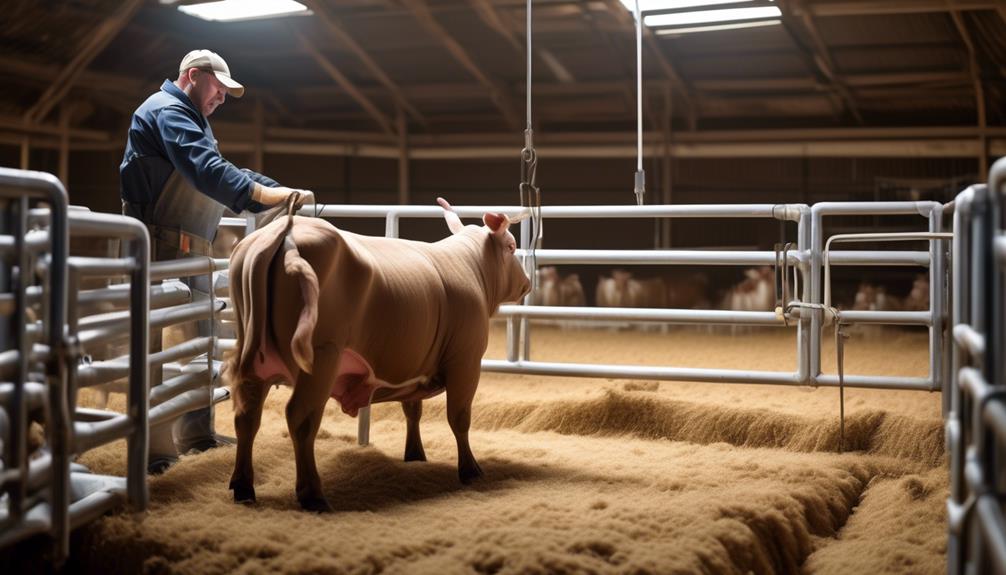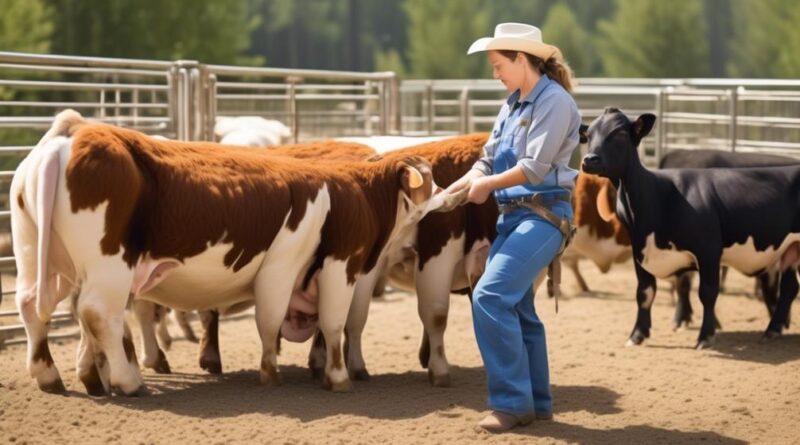Mastering Advanced Livestock Handling Techniques: 7 Expert Tips
You may think that you already have a good handle on livestock handling techniques, but mastering advanced methods can take your skills to the next level. With the constant evolution of best practices in animal welfare and efficiency, staying up-to-date with the latest expert tips is crucial.
As you navigate through the complexities of handling livestock, you'll find that there are seven key techniques that can significantly improve your approach. From low-stress handling methods to utilizing advanced restraint systems, these expert tips will enhance your livestock management in ways you might not have considered.
Utilizing Low-Stress Handling Methods

To minimize animal stress during handling, employ gentle and patient techniques to ensure their well-being and safety. Improving communication is key to successful low-stress livestock handling. Utilize body language and vocal cues to convey calmness and reassurance to the animals. Move slowly and deliberately, avoiding sudden movements that can startle or agitate them. Building trust is a gradual process that requires consistent and positive interactions. Spend time in the animals' environment, allowing them to become familiar with your presence. Offer treats and gentle pats to associate your presence with positive experiences.
When handling livestock, it's essential to understand their natural instincts and behaviors. By observing and learning their body language, you can anticipate their reactions and adjust your handling techniques accordingly. Use tools such as flags or paddles to guide the animals with minimal physical contact. This helps maintain a safe distance while still effectively directing them.
Furthermore, creating a low-stress environment involves minimizing loud noises and sudden disturbances. Be mindful of the surroundings and avoid unnecessary disruptions that could startle the animals. By maintaining a calm and predictable atmosphere, you can significantly reduce the stress levels of the livestock.
Implementing Proper Sorting Techniques
Understanding the natural instincts and behaviors of livestock plays a crucial role in implementing proper sorting techniques to ensure their well-being and safety. By comprehending how animals naturally behave and react to different stimuli, you can develop sorting methods that minimize stress and handling issues.
Here are some expert tips to help you master proper sorting techniques:
- Sorting Efficiency:
- Use animal behavior to your advantage: Understanding how livestock naturally move and react to stimuli can help you develop sorting strategies that are efficient and low-stress.
- Utilize stockmanship skills: By honing your stockmanship skills, you can better understand how to work with the natural instincts of livestock, making the sorting process smoother and less stressful for the animals.
Implementing proper sorting techniques not only enhances sorting efficiency but also reduces handling stress on the animals. By leveraging your understanding of animal behavior and honing your stockmanship skills, you can create a more harmonious and efficient sorting process.
This not only benefits the animals by reducing stress but also improves overall handling efficiency and safety for both the livestock and the handlers.
Designing Efficient Handling Facilities

When designing efficient handling facilities for livestock, prioritize the layout and equipment to minimize stress and optimize workflow. Efficient facility design plays a crucial role in ensuring the smooth handling of livestock. Start by considering the natural behavior of the animals. Design the layout in a way that allows for easy movement of the animals from one section to another. This can be achieved by incorporating curved chutes and races to mimic the natural movement patterns of the livestock. Additionally, utilizing non-slip flooring and solid sides in the handling facilities can help reduce stress by providing a sense of security to the animals as they move through the system.
Livestock behavior management should also be a key consideration when designing handling facilities. Understanding how animals perceive and react to their surroundings is essential in creating an efficient and low-stress environment. By incorporating features such as curved walkways, lighting adjustments, and strategically placed barriers, you can guide the animals through the facility with minimal resistance and stress.
Furthermore, utilizing hydraulic or pneumatic equipment for sorting and handling can significantly improve the efficiency of the facilities, reducing the need for excessive physical exertion.
Maximizing Cattle Flow and Movement
Consider how you can optimize cattle flow and movement within the efficient handling facilities you have designed. Improving handling efficiency is crucial for minimizing stress levels in cattle, which ultimately leads to better overall herd health and productivity. Here are some expert tips to help you maximize cattle flow and movement:
- Facility Layout
Ensure that the layout of your handling facilities allows for smooth and continuous cattle movement. Design alleys and gates to facilitate a natural flow of cattle from one area to another without any sharp turns or obstacles. This will minimize stress and encourage cattle to move more easily through the handling system.
- Use of Behavioral Principles
Utilize behavioral principles to understand how cattle perceive and react to the handling facilities. By incorporating elements such as non-slip flooring, solid sides, and gradual lighting transitions, you can create an environment that minimizes stress and anxiety in cattle, thus improving their movement through the facilities.
Applying Advanced Restraint Systems

To enhance cattle handling efficiency, implement advanced restraint systems that prioritize both animal welfare and personnel safety. Understanding animal behavior is crucial when applying advanced restraint systems. By recognizing stress signals, such as vocalizations, ear position, and body movements, you can adjust the restraint system to minimize distress. Pay attention to the animal's flight zone and point of balance to ensure a smooth and stress-free restraint process.
When applying advanced restraint systems, stress management is paramount. Utilize low-stress handling techniques and ensure that the restraint system allows for minimal struggling and discomfort. This can be achieved by using well-designed equipment that securely holds the animal without causing unnecessary anxiety. Additionally, consider implementing positive reinforcement methods to accustom the animals to the restraint system, further reducing stress during handling.
Advanced restraint systems should be designed to provide easy access for personnel to perform necessary tasks while keeping the animals safe and secure. This may involve adjustable features that cater to different animal sizes and behavioral tendencies. Proper maintenance and regular inspections of the restraint equipment are also essential to ensure that it functions effectively and doesn't cause undue stress to the animals.
Utilizing Technology for Monitoring Livestock
Utilize modern technology to enhance livestock monitoring and management, ensuring proactive care and precision in husbandry practices. By incorporating advanced monitoring systems and livestock tracking, you can revolutionize the way you oversee your animals' health and behavior. Here's how you can make the most of technology for monitoring your livestock:
- Monitoring Systems
Implementing sensor-based monitoring systems allows you to track vital parameters such as body temperature, heart rate, and feeding behavior in real-time. This data can offer valuable insights into the health and well-being of individual animals, enabling early detection of any potential issues.
- Data Analytics and Remote Sensing
Leveraging data analytics tools can help you process the vast amount of information collected from monitoring systems, enabling you to identify trends and patterns that may impact the overall herd health. Additionally, remote sensing technologies like drones equipped with thermal imaging cameras can provide aerial views of your pastures, aiding in the detection of any anomalies or distressed animals, thus allowing for prompt intervention.
Integrating these advanced technologies into your livestock management practices can lead to more efficient and proactive care, ultimately improving the well-being of your animals and the overall productivity of your operation.
Ensuring Safety and Welfare Practices

Implementing robust safety and welfare practices is essential for the well-being of your livestock and the overall success of your operation. By establishing and strictly enforcing safety protocols, you can ensure the health and happiness of your animals while also minimizing the risk of accidents or injuries to both the livestock and your team. Regularly inspecting and maintaining handling facilities, such as pens, chutes, and fences, is crucial to prevent potential hazards and ensure a secure environment for your livestock. Proper training for your team in animal handling techniques is also vital for the well-being of the animals and the safety of the handlers.
Ensuring the highest standards of animal well-being involves providing appropriate nutrition, access to clean water, and suitable shelter. Regular veterinary care and prompt attention to any signs of illness or injury are essential components of ensuring the welfare of your livestock. It's also important to consider the mental well-being of your animals by providing them with adequate space for movement and social interaction.
In addition to physical well-being, consider the emotional well-being of your livestock. Handling animals calmly and patiently helps reduce stress and fear, ultimately contributing to their overall welfare. By prioritizing safety and welfare practices, you aren't only ensuring the health and happiness of your livestock but also building a foundation for the long-term success of your operation.
Optimizing Handling Equipment and Tools
Enhancing livestock handling efficiency begins with selecting and maintaining appropriate equipment and tools for the task. When it comes to optimizing handling equipment and tools, there are several key factors to consider:
- Choosing the Right Equipment:
- Select equipment that's suitable for the specific livestock species you're handling. For example, if you're working with cattle, ensure that your handling facilities are designed to accommodate their size and behavior. This can include features such as adjustable alleys and chutes to minimize stress and encourage smooth movement.
- Invest in quality tools that are designed to improve efficiency while minimizing stress on the animals. This can include items such as non-slip stock sticks, well-designed sorting panels, and quiet handling facilities.
Frequently Asked Questions
What Are the Most Common Mistakes Made by Beginners When Implementing Low-Stress Handling Methods?
When implementing low-stress handling methods, beginners often make common mistakes that include missing stress indicators, mishandling aggressive animals, and using ineffective sorting techniques. It's crucial to learn and avoid these errors for successful livestock handling.
How Can Livestock Handlers Effectively Manage Aggressive Animals During Sorting Techniques?
When managing aggressive livestock during sorting, focus on understanding animal behavior, stress management, and effective communication. Use safe handling techniques and training methods to ensure safety for both you and the animals.
What Are Some Key Considerations When Designing Handling Facilities for Multiple Species of Livestock?
When designing handling facilities for multiple species, consider animal behavior and stress management. Ensure the layout allows for smooth livestock handling. Minimize corners and use non-slip flooring to reduce stress and improve safety for both animals and handlers.
Are There Any Specific Strategies for Managing Cattle Flow and Movement in Challenging Environments Such as Extreme Weather Conditions?
In extreme weather, managing cattle movement is crucial for their welfare. Consider using windbreaks and providing access to shelter. Maximize handler safety by planning routes and using low-stress handling techniques to ensure smooth cattle flow.
What Are Some Advanced Restraint Systems That Are Particularly Effective for Handling Large or Unruly Livestock?
When dealing with large or unruly livestock, advanced restraint systems can be particularly effective. Understanding livestock behavior and using proper equipment can help you manage and handle these animals safely and efficiently.
Conclusion
In conclusion, mastering advanced livestock handling techniques is essential for the safety and welfare of your animals.
By utilizing low-stress handling methods, proper sorting techniques, and efficient handling facilities, you can maximize cattle flow and movement while ensuring their well-being.
Additionally, applying advanced restraint systems and utilizing technology for monitoring livestock will further enhance your handling practices.
With a focus on safety and optimization of handling equipment, you can become an expert in livestock handling.
